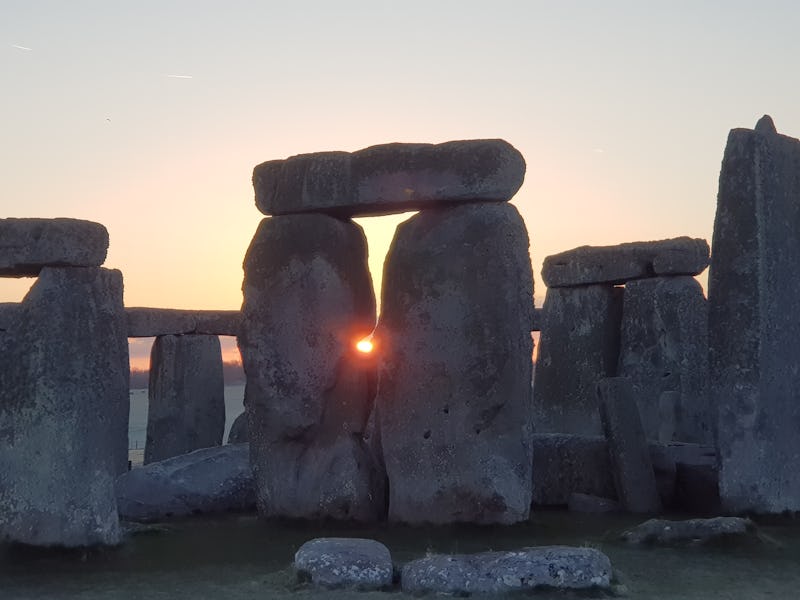Stonehenge Marks the Solstice, but That's All Scientists Know for Sure
They're still wrestling with three very different theories.

In Wiltshire, about 9,500 people gathered on Thursday around that famous Neolithic circle of sarsen slabs and subvolcanic dolerite known as Stonehenge to watch the early morning light rise in alignment with the monument’s Heel Stone and Slaughter Stone. This only happens at Stonehenge at the dawn of the summer solstice — that’s today, guys — and that bit of trivia is no coincidence. The ancient people who built Stonehenge and its many iterations, during the late Stone Age period from about 3100 to 1600 BC, built it to mark both the longest and shortest days of the year (the summer and winter solstices). Why, exactly, is not precisely understood, because Stonehenge was built by a prehistoric society that left no written records, but there are theories.
In the 1950s, archeologists like Richard Atkinson, who helped conduct excavations at Stonehenge for the UK Ministry of Works, could scarcely believe that ancient Britons had been capable of building Stonehenge themselves without the aid of a more advanced civilization. But today, recent archeological finds have revealed evidence of many more sophisticated architectural structures made of wood, including similar, astronomically aligned sites, like Durrington Walls and Woodhenge, that provide a better understanding of just how resourceful and capable these prehistoric people really were.
The theories for why Stonehenge was built fall into two broad categories: archaeologists who see it, first and foremost, as a holy site, built around the movements of celestial bodies, and their colleagues, who see it as more of a practical tool, a giant calendar made to track the seasons for agricultural purposes.
Religious site, cemetery, or just a plain old calendar? It's still up for debate.
A Religious Site
A team of archeologists led by Tim Darvill of Bournemouth University found enough evidence of Bronze Age skeletons with bone deformities in the Earth surrounding Stonehenge to put forward the hypothesis that the monument was seen as a place for mystical healing. As Darvill told the press in 2008, he believed that Stonehenge was probably seen as “the accident and emergency unit of southern England.” Deep religious significance, he and his collaborator Geoffrey Wainwright maintained, was one of the few plausible explanations for why these ancient people hauled gigantic, glittering, dolerite “bluestones” roughly 250 kilometers from northern Wales.
A Cemetery Plot
A rival theory, advanced by Sheffield University’s Mike Parker Pearson, suggests that Stonehenge was a cemetery plot, likely for some prehistoric ruling dynasty. Radiocarbon dating of the human remains around the site, as Pearson told National Geographic, “shows that Stonehenge, from its beginning to its zenith, is being used as a place to physically put the remains of the dead.”
Whatever it used to be, Stonehenge is now a party destination.
A Giant Calendar
The longest-running and most commonsensical answer as to why Stonehenge exists, of course, is that it allowed for the tracking of seasons for agriculture, but even this explanation has some inconsistencies to account for. In 2012, archaeobotanists Chris Stevens and Dorian Fuller of University College London found evidence that most of the people living near Stonehenge were herders during the Neolithic period and, as such, might have been doing less farming — and had less of a need for some giant, elaborate stone almanac.
In the late ‘60s and early ‘70s, an extreme version of this theory advanced to the point where researchers were describing Stonehenge as if it were an ancient computer — a primitive but powerful astronomy observatory designed to help calculate not just the seasons and the solstices, but solar eclipses and other celestial phenomena. It’s a wild and fun premise, but as Clive Ruggles, a professor of archaeology and ancient history at the University of Leicester, put it decades later, the theory is “one of the most notorious examples known to archaeologists of an age recreating the past in its own image.”
Whatever the case, that stretch from 3100 to 1600 BC is a really long time, and there are plenty of things that many of us don’t even use for the same reasons that we did only just a few short years ago (cell phones, Facebook, reasonably flattering and comfortable athletic wear).
So, Stonehenge was probably a pretty cool venue that really evolved with the times — in no small part thanks to its timeless design around the longest and shortest days of the year.